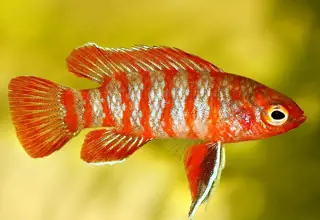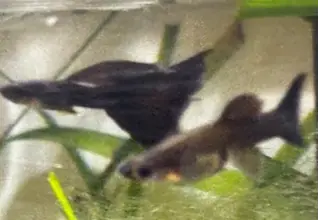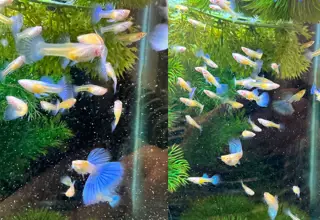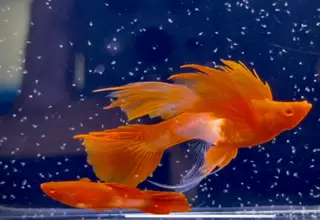Divided Betta Fish Tanks: Everything You Need To Know
Posted by Miles Harrison on 09/26/2022
We use affiliate links and may receive a small commission on purchases.
One of the most popular aquarium fish, the Betta fish (Betta splendens), is a common entry point into the aquarium hobby. Frequently sold in pet shops and local fish stores, the Betta fish is a staple freshwater species that is fun to observe.
Experienced aquarists love betta fish so much that they often like to keep them in one single aquarium. If you’re looking to house multiple bettas in one tank, dividing the aquarium is a great option for this territorial species.
In this post, we’ll briefly discuss some basic betta fish care requirements and go over a popular aquarium setup, the divided betta fish tank .
Table of Contents
January's Giveaways on Light Fish
Species Summary
Occasionally referred to as Siamese Fighting Fish, the Betta fish is one of the most common types of freshwater fish available in the hobby. Through selective breeding, the body of the betta fish can come in almost any color imaginable.
Native to Malaysia, Indonesia, Vietnam, Laos, and Cambodia, these fish live in shallow rice paddies and slow-moving streams. As such, you’ll want to re-create this environment in an at-home aquarium.
🛒 Shop Freshwater Fish on Light Fish
Betta Fish Appearance
Adult versions of this fish are typically around 3 inches in length. The fish’s body consists of small scales that overlap each other, and have upturned mouths which they use to catch surface-dwelling food sources.
In the wild, these fish have a rather dull color, but through selective breeding, a large variety of color patterns have emerged. Betta fish have been known to come in yellow, black, white, green, even neon colors have bred into the species. Exotic patterns, such as the Galaxy Koi are increasing in popularity due to their rarity.
Interestingly, these fish have used their new color patterns to enhance their mating displays. One of the most distinctive features of this fish is its ability to flare its fins and gills, which they do to display dominance when another fish encroaches on their territory.
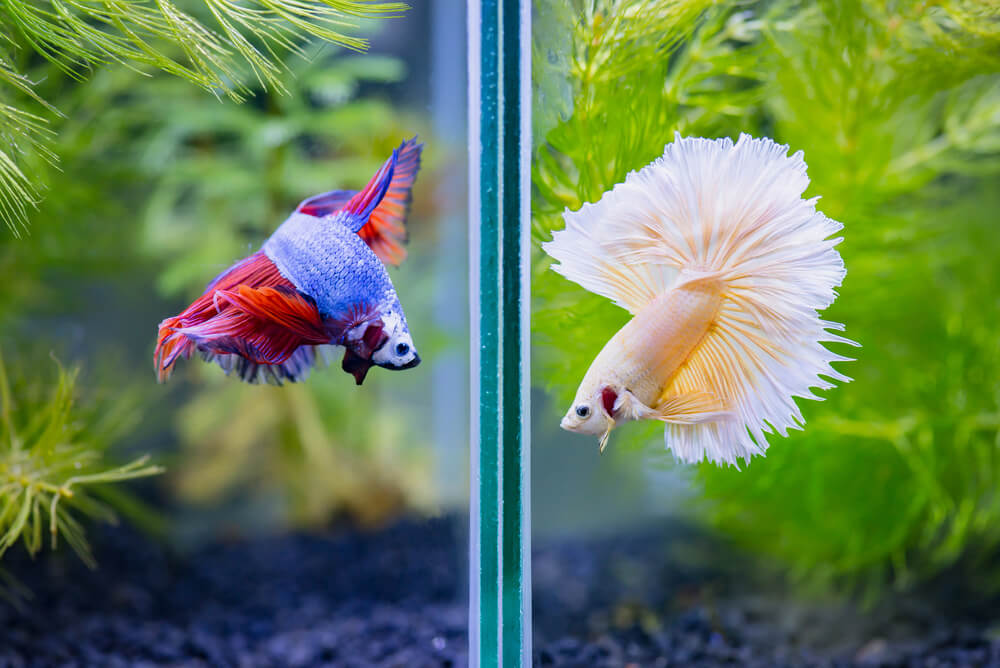
Care Requirements
Due to a lack of knowledge, betta fish are often uncared for. It’s important to know that betta fish do not have the easiest of care requirements, even if they are advertised otherwise. If you’re just housing one betta, you’ll need at least a 5-gallon aquarium with a heater, proper filtration, and plenty of hiding spots throughout the tank. You’ll need to perform bi-weekly water changes, and monitor water chemistry for dangerous spikes in ammonia or nitrite.
Betta fish should be introduced into established aquariums, and not used as fish to induce the nitrogen cycle. If you’re new to the hobby, we recommend reading up on the nitrogen cycle before purchasing your first betta fish.
Given optimal water conditions and a sufficient environment to swim in, these fish should be extremely active and should be constantly investigating their tank for new food sources.
It’s extremely important to know that betta fish are an aggressive species, and should be kept as the only fish in an aquarium.
Lifespan
Betta fish are a relatively short-lived species. When given optimal water conditions and a proper diet, these fish have been documented to live for about 2-5 years in captivity.
Most of the time, purchased bettas are usually around 1-2 years old, so you can expect to have this wonderful species for an additional 3 years in a home aquarium.
Many aquarists enjoy the personalities of these fish so much, they often want to purchase another! However, it can be quite expensive to create two separate aquariums. One solution that is increasing in popularity is the divided betta fish tank. Keep reading to learn more about this unique approach to betta fish keeping!
Divided Betta Fish Tanks
If you’ve been to a local fish store recently or even browsed the explore page on websites like Instagram, you may have come across a unique-looking fish tank, the divided betta fish tank.
Divided betta fish tanks are large aquariums with opaque dividers that split the aquarium into halves, 3rds, and even 4ths! These aquariums provide a healthy living environment for multiple male betta fish.
One of the best parts about these tanks is that you don’t need to purchase one in-store, you can build a budget-friendly version yourself!
Divided Betta Fish Tank Appearance
These aquariums are interesting to look at. Divided betta fish tanks are usually wider than most, and typically have one or multiple dividers that split the water column. These dividers allow multiple male betta fish to live in the same aquarium without experiencing territorial disputes.
Tank Size
Divided Betta Fish Tanks should typically be at least 5 gallons in size per betta fish. So for tanks divided in half, you’ll want an aquarium of at least 10 gallons. If the tank is divided into thirds, you’ll want 15 gallons, and so forth.
Betta fish need plenty of room to swim in, and a divided tank is no different. Ensuring you have at least 5 gallons per fish will allow the betta to live a healthy and active life. It also leaves room for you to add plenty of plants or stones for your betta to hide in and investigate.
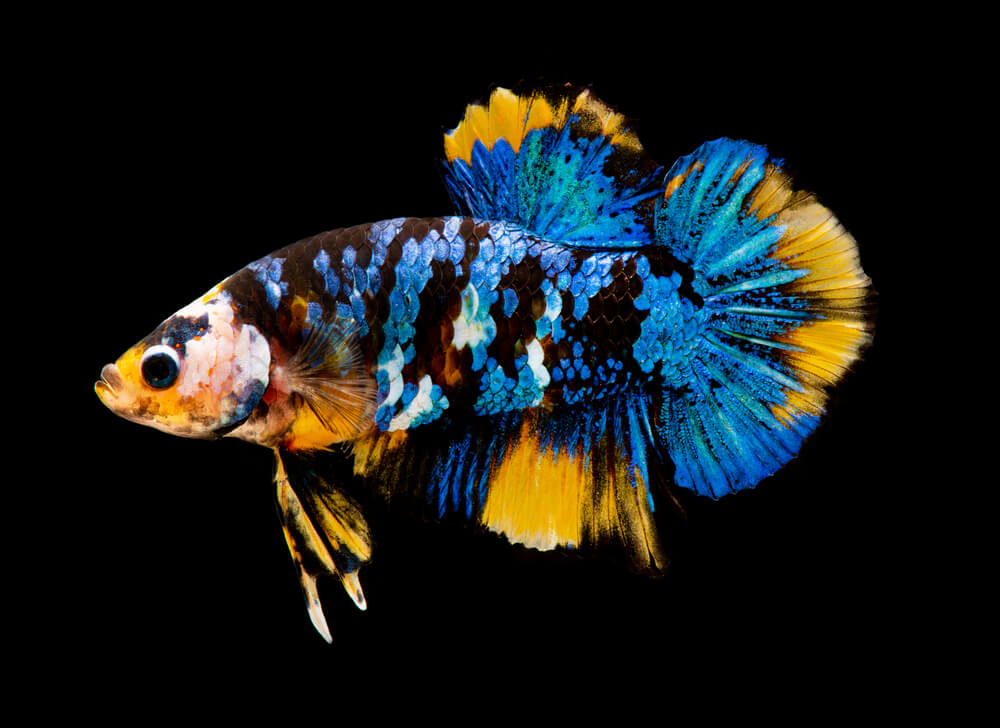
Dividers
There are plenty of available dividers for sale on sites like Amazon for hobbyists looking to split their aquariums. Plastic dividers can be used to separate sections of the water column, but you’ll want to make sure that the plastic is completely opaque. Betta fish will easily become stressed if they see another male species.
Where to Buy a Divider
Aquarium dividers can be purchased on websites like Amazon, and eBay, and are occasionally listed under the tank section on Light Fish. Dividers are plastic and opaque and are typically fastened to the bottom of a fish tank.
How to build your Divider
One of our favorite ways to divide a betta fish tank is using a natural approach. Rock and stone may be glued down to the bottom of an aquarium, creating a natural divide for the betta fish. As long as the betta fish cannot get through the rock wall, you can successfully create this divide.
You can also purchase premade divided betta fish tanks. While a lot of these tanks are made of plastic materials, they are a much more affordable option compared to building a natural aquascape.
Water Conditions
You’ll want to maintain optimal water conditions in your divided betta fish tank. If you’re used to housing one betta fish, you should know that adding fish means more fish food, and ultimately more fish waste. This waste eventually decays, creating an increase in ammonia and nitrite. This spike in chemistry levels can be lethal for betta fish. To prevent this, you’ll want to make sure your aquarium is fully cycled so that beneficial bacteria can convert ammonia and nitrite into unharmful nitrate.
Adding live plants to a divided betta tank is a great idea, as these plants will act as a natural filter.
You’ll also need to perform bi-weekly water changes. Performing 30% water changes on a bi-weekly basis will keep your aquarium water clean.
Filtration Recommendations
There are many suitable filter options for a divided betta fish tank. Owning a divided fish tank comes with unique challenges. You’ll want to ensure that your water is being filtered throughout each divided section.
Canister filters are great for this, you can place the inflow pipe on one side of the aquarium, and the outflow pipe on the other. This distance will draw water across each section of the divided aquarium. We recommend any of the canister filters that are compatible with your aquarium size from the brand Eheim.
Another great option are HOB filters, more commonly known as hang-on-the-back filters. Typically, only one of these filters is used for a single betta. However, it might be difficult to position a hob filter in a divided tank. If possible, we recommend having multiple HOB filters for each section of your divided betta tank. This will ensure that each section benefits from the increased oxygen HOB filters provide, due to their ability to break the surface of the water.
Habitat Setup
Now, let’s discuss setting up the habitat for your divided aquarium tank. You’ll want to provide a high-quality substrate for your betta fish. Substrates such as CaribSea's Eco-Complete are excellent for freshwater aquariums, as these nutrient-rich substrates will pair nicely with plants.
If you choose not to add plants, any sort of fine-grained gravel-based substrate will be appreciated by your betta fish.
You’ll also want to decorate and provide plenty of hiding spots for the betta fish in your divided tank. Betta fish will occasionally hide out in different locations throughout an aquarium. If you provide a lot of aquarium plants, such as Java Fern or Anubias, you may catch your betta fish resting amongst the leaves.
Purchasing large rocks, and positioning them to create small caves will also be enjoyed by your betta fish.
You’ll want to re-create these habitats for each section of your divided betta tank. This will ensure that your fish have everything they need to live a happy and healthy life!
Food & Diet
Betta fish are not picky eaters and will accept high-quality flake food, as well as nutrient-enriched pellets. In a divided tank, you’ll want to make sure that each housed betta fish has access to enough food. Feed each betta fish separately, so that you can closely monitor how much food they are consuming.
You’ll want to feed the fish in your divided tank at least one to two times a day. Betta fish love to eat but make sure that there is not a lot of food leftover. Excessive waste can accumulate at the bottom of the tank, causing an increase in ammonia. Since you’ll have a divided aquarium, toxicity in one section of the tank will quickly spread to the other.
You can prevent ammonia buildup by doing the bi-weekly water changes we previously mentioned.
Tankmates
Typically, you’ll want to have only one betta fish for each divided section. Due to their territorial personality, you’ll want to avoid adding any additional fish. However, this does not mean you can’t have any tankmates.
Betta fish do quite well with other freshwater shrimp, such as Cherry shrimp, Ghost shrimp, and Amano shrimp. Betta fish will also live with amphibians, such as African Dwarf frogs, and other invertebrates such as Assassin and Mystery snails.
If you plan on adding any of these other species as tankmates, you’ll want to be sure that they have plenty of hiding spots in case the betta fish shows territorial behavior. Creating an optimal environment with plenty of hiding spots will reduce any undue stress placed on new tank inhabitants.
Behavior and Temperament
Betta fish will be quite active in a divided aquarium. As long as they have at least 5 gallons of water to themselves, they will do a lot of swimming. One common issue that new bettas experience is a lack of personality in their betta. One of the most common causes of this is forgetting to include a heater in your aquarium. Betta fish require a heater, as they prefer warmer waters. Temperatures should always be between 75°F-78°F.
In a divided tank, you’ll want to make sure that these temperatures are consistent across each area in the divided aquarium. Luckily, most heaters, such as the one made by Aqueon , do an excellent job regulating aquarium temperature regardless of tank size.
Assuming your water conditions are in top shape, your filters are running, a heater is present, and enough space is provided, your betta fish should actively swim throughout the water column!
Now, let’s discuss personality. Betta fish are quite aggressive, and this is important to know when you plan on keeping a betta fish in a divided tank. If two male bettas can see each other, they will show signs of aggression. This aggressive behavior stresses betta fish, which can ultimately lead to their death. If you plan on keeping a divided betta tank, you must ensure that each male betta cannot visually see one another.
Pros and Cons of Dividing a Betta Fish Tank
There are many positives to having a divided betta fish tank. You’ll save money on purchasing equipment since you’ll only need to maintain one dedicated aquarium. This is excellent as you may need to only purchase one filter and one heater. You’ll also benefit from having to perform water changes on only one aquarium, as opposed to multiple.
Seeing multiple betta fish in one aquarium is a rare sight to see, and people will quickly be impressed by your ability to keep betta fish in such proximity!
However, there are some cons when it comes to owning a divided tank. The biggest con is shared water chemistry. If your water quality is poor, you now have multiple fish that are being affected by poor water conditions. You’ll also need to consistently ensure that your betta fish can not see each other, or jump into another section of the tank. Having a tight-fitting lid , and ensuring whatever is being used to divide the tank cannot be undone, will guarantee your success in housing multiple bettas in one divided tank.
In Summary
As you can see, owning and providing for a divided betta fish tank is no easy feat. Most aquarists will opt to house their betta fish in a single tank.
After reading this post, you are now equipped with the knowledge needed to house multiple betta fish in a single divided aquarium.
Betta fish are some of the most vibrant species of freshwater fish, and seeing them swimming in a divided aquarium is a sight that is sure to please!
January's Giveaways on Light Fish


